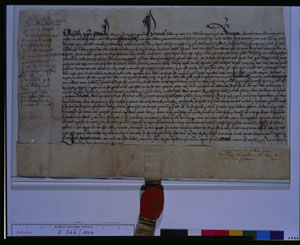 |
 |
 |
 |
 |
 |
 |
|
Roche Abbey: the sources (1/1)
There are few surviving documentary sources for Roche Abbey, for many of the abbey’s muniments, stored in a chest in St Mary’s Tower, York, were lost or destroyed during the Civil War siege of York in June 1644, when the Parlamentarians blasted the tower.(1) Fortunately, several seventeenth-century antiquaries had already transcribed some of the documents from the various religious houses; others survived the blast and are preserved in later copies. Roger Dodsworth’s transcriptions of a selection of Roche’s charters in the seventeenth century are now kept in the Bodleian Library, Oxford,(2) and printed in Dugdale’s Monasticon.(3) Another set of transcripts was copied in the nineteenth century at Hooten Levett Hall, Rotherham, ‘made, doubtless, for some legal purpose’ .(4) These fourteen charters were edited and published by Addy in 1878 as Roche Abbey Charters, and supplemented with two original charters rescued by Dr Sykes, a localman of Rotherham; one, he retrieved from a drawer in a stationer’s office, the other from a sackful of old documents about to be shredded by a gardener and used to fasten branches to the wall.(5) As well as documentary sources, there are various surviving artefacts, some of which were recovered during excavation of the site. These include lead fragments, wax seals, and pieces of coloured glass. Whilst little remains of the buildings, aerial photography of the precinct is highly revealing and shows an extremely clear outline of the site.
In addition to these two sets of transcripts, miscellaneous documents relating to Roche are scattered throughout royal and county record collections. The dissolution of the house is well documented in the reports of Henry VIII’s commissioners, Doctors Layton and Leigh, and a remarkable description of the spoliation at Roche survives in an eighteenth-century copy.(6) |
||||
|
|
||||
